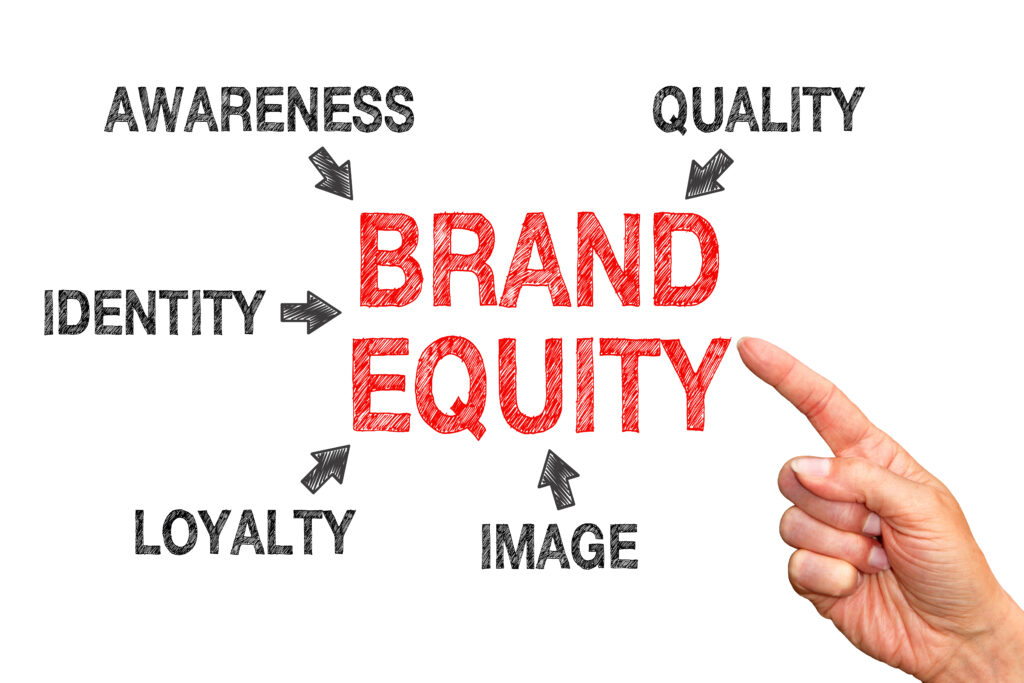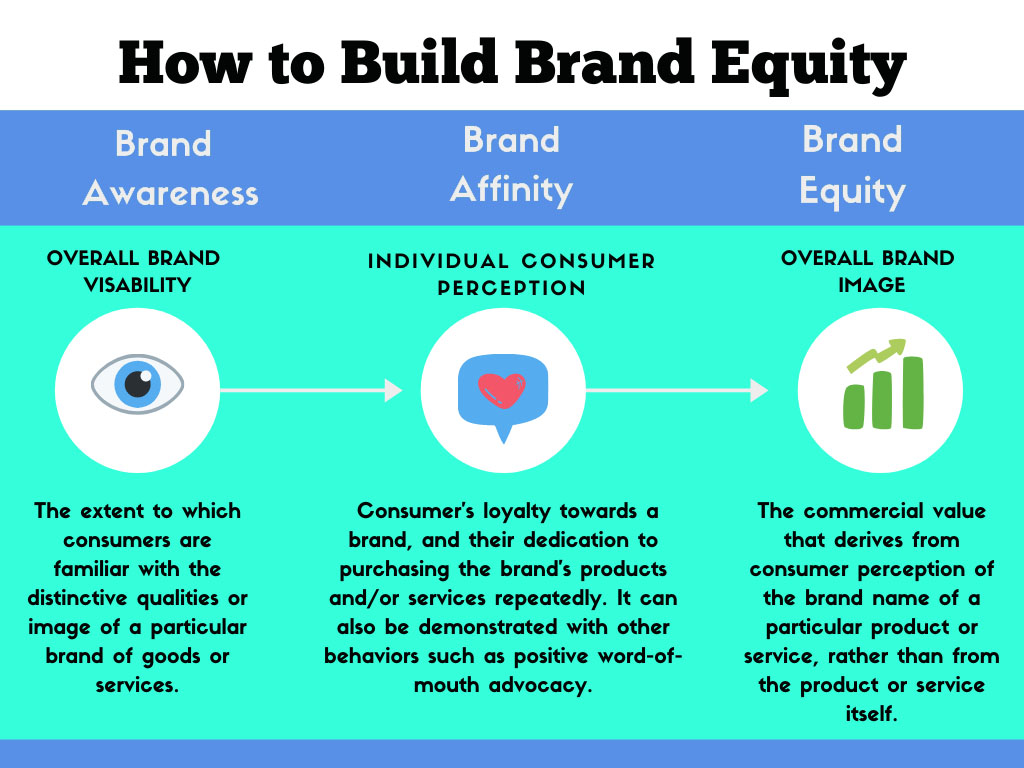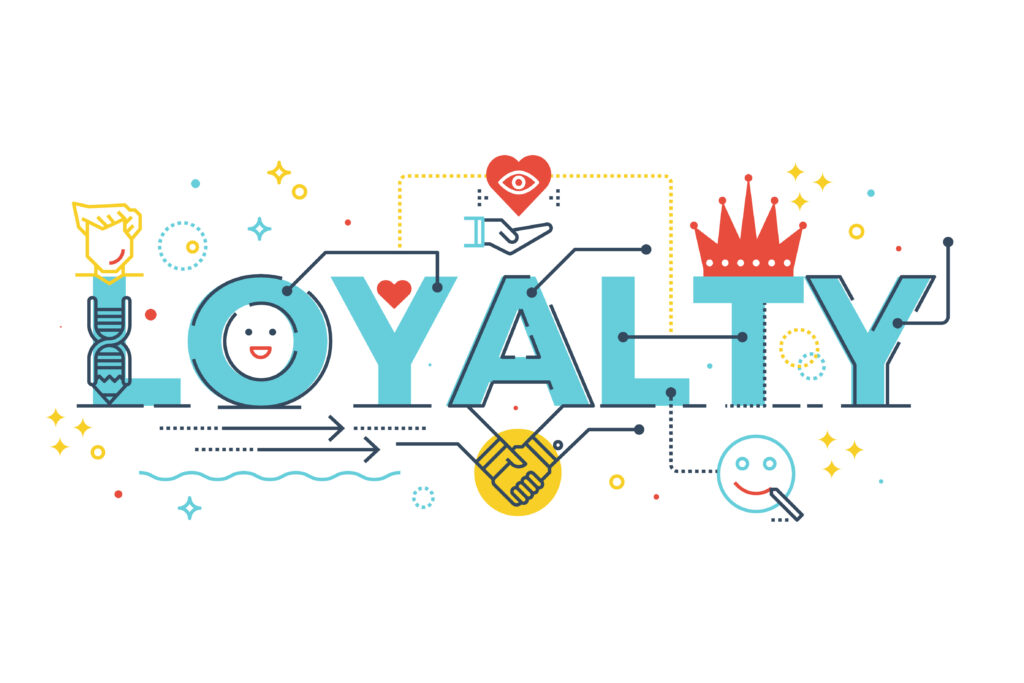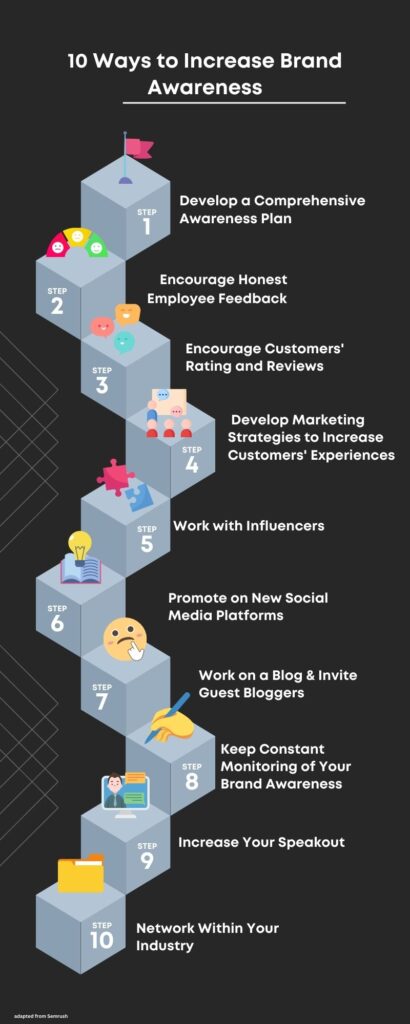Enhancing Your Brand Equity: Strategies for Success

Table of Contents
In the competitive landscape of startups, it is crucial to employ effective strategies to stand out, attract customers, and build a strong foundation for success. This guide provides insights into five essential strategies for startups: focusing on a niche market, leveraging digital marketing, offering exceptional customer service, continuously innovating and adapting, and building strong partnerships. By implementing these strategies, startups can establish their brand, connect with their target audience, and create a solid path towards growth and sustainability.
Brand Equity
Brand equity refers to the commercial value and intangible assets associated with a brand name, beyond its physical and tangible attributes. It represents the perception, reputation, and overall value that a brand holds in the minds of consumers and in the marketplace. Brand equity is built over time through various factors such as brand awareness, customer perception, brand associations, and brand loyalty.
There are several components or dimensions that contribute to brand equity:
-
Brand awareness: The level of recognition and familiarity consumers have with a brand. It includes both brand recognition (the ability to identify the brand) and brand recall (the ability to remember the brand when prompted).
-
Brand associations: The attributes, qualities, and characteristics that consumers mentally link to a brand. These associations can be functional (e.g., quality, performance) or emotional (e.g., trust, loyalty).
-
Perceived quality: The perceived level of excellence or superiority of a brand’s products or services compared to competitors. Positive perceptions of quality contribute to higher brand equity.
-
Brand loyalty: The degree of customer attachment and commitment to a brand. Loyal customers are more likely to repurchase, recommend the brand, and resist competitive offers.
-
Brand personality: The set of human-like traits, values, and characteristics that consumers associate with a brand. A strong brand personality helps create a unique identity and emotional connection with consumers.
-
Brand reputation: The overall perception and standing of a brand in the marketplace. A positive reputation enhances brand equity, while negative experiences or public relations issues can diminish it.
Brand equity is valuable because it can lead to several business benefits, including increased customer loyalty, higher market share, premium pricing power, and the ability to successfully launch new products or expand into new markets. It is a strategic asset that companies invest in and cultivate to differentiate themselves from competitors and build long-term sustainable growth.
Why is Equity so Important for Brand Value?
Brand equity is the base for brand value. The perspective people place over brands gives recognition and value to their products. For example, you go into a supermarket to buy a product. Over 20 brands are selling the same product. You may get confused from seeing so many products in the same category, but you believe one is the best. You have never tried the product before, and you have no idea how it tastes, but still, you think it is the best one. So, you end up purchasing the product.
What just happened is the best example of brand equity. You are buying something based on what other people say about the product. Maybe the product is not the best, but it has an excellent brand positioning that brings more revenue and makes it more and more competitive.
The power of this concept increases the brand value, bringing more proceeds and shares of the market and empowering the business.

Establishing Brand Identity: Defining and Communicating Your Brand’s Unique Value
Brand value is built on a brand’s personality. It includes the visual, verbal, and emotional parts of your brand that make it shine and substantially impact customers. To build a strong brand personality, you need to find out what makes your brand special and tell your target audience about it. Here are some examples of actual companies that have done an excellent job of establishing their brand identities:
- Apple: Apple has built its brand around creativity, ease, and great design. People like their goods because they look nice, have easy-to-use platforms, and use cutting-edge technology. Apple’s brand identity is shown through its simple ads, the famous Apple logo, and its slogan, “Think Different,” which speaks to its target audience of creative people.
- Nike: Nike has built a strong brand personality linked to sports success and motivation. Their “Just Do It” phrase has come to mean hard work and pushing yourself to the limit. The “swoosh” image and strong ads with famous athletes help to build Nike’s brand personality even more.
- Coca-Cola: Coca-Cola has done a good job of building a brand personality around happiness, memories, and sharing happy times. With their famous red-and-white image and touching ads, they make an emotional link with their customers. Coca-Cola’s brand personality is boosted because they always talk about bringing people together and celebrating life’s special times.
- Tesla: Tesla has built a brand name around being environmentally friendly, using cutting-edge technology, and shaking up the car industry. They show who they are as a brand through their sleek electric cars, forward-thinking marketing efforts, and goal of making the future more sustainable. Tesla’s brand personality speaks to people who care about the environment and want new ways to get around.
To set up the character of your brand, you need to carefully describe its core beliefs, unique selling points, and target audience. Communicate these things consistently through your visual branding, message, material, and how your customers interact with you. By making an exciting and consistent brand identity, you can differentiate from your competitors and build a strong brand that connects to your target market.
Building Brand Awareness: Effective Tactics for Increasing Recognition and Recall
Brand equity requires brand awareness. How well shoppers know your brand. Effective strategies may boost brand recognition and keep your brand top-of-mind among your target audience. Brand awareness examples from genuine companies:
McDonald’s is a worldwide brand. McDonald’s has excellent brand recognition due to its vast restaurant network, recognizable golden arches, and consistent branding. Their catchy jingles, like “I’m Lovin’ It,” and sponsorships with famous events like the Olympics have helped customers remember their brand.
Airbnb: Offering unique accommodations changed the tourism sector and increased brand exposure. Airbnb has developed a travel brand via smart marketing, collaborations, and word-of-mouth. Their logo and enticing visuals also help them stand out.
Red Bull’s relentless marketing has built brand recognition. Red Bull has become associated with energy, adventure, and vitality via extreme sports sponsorships, high-intensity events like Red Bull Air Race, and engaging social media content.
Old Spice: Viral and hilarious ads helped Old Spice, a men’s grooming company, rebrand itself. Their captivating “The Man Your Man Could Smell Like” advertising raised brand recognition and sales.
Social media, influencer collaborations, content marketing, and advertising may boost brand recognition. Storytelling, visuals, and brand experiences engage audiences. All touchpoints must have a consistent message, visual identity, and consumer interactions. Increase brand recognition and remain top-of-mind with customers by using effective strategies and building a distinctive brand persona.
Effective Strategies to Develop Brand Awareness for Startups
For a startup, developing brand awareness is crucial to establish a presence in the market and attract customers. Here are some effective strategies to begin building brand awareness:
-
Define your brand identity: Start by clearly defining your brand identity, including your mission, values, and unique selling proposition. Understand your target audience and what sets your startup apart from competitors. This clarity will guide your brand messaging and communication efforts.
-
Create a compelling brand story: Craft a compelling narrative that communicates your startup’s purpose, vision, and value proposition. Tell your story in a way that resonates with your target audience and creates an emotional connection. Share this story through your website, social media profiles, and other marketing channels.
-
Build a strong online presence: Establish an online presence through a well-designed website and active participation on relevant social media platforms. Optimize your website for search engines (SEO) to increase visibility. Consistently publish valuable content related to your industry or niche to position yourself as an expert and attract organic traffic.
-
Leverage social media: Select social media platforms that align with your target audience and engage actively on those platforms. Share valuable content, participate in industry discussions, and interact with your audience. Utilize social media advertising to reach a wider audience and boost visibility.
-
Collaborate with influencers: Identify influencers or micro-influencers in your industry who have an engaged audience that aligns with your target market. Collaborate with them to create content, sponsored posts, or reviews that promote your startup. Influencers can help amplify your brand message and reach new potential customers.
-
Utilize content marketing: Develop a content strategy that provides value to your target audience. Create blog posts, videos, infographics, or podcasts that address their pain points, offer solutions, or share industry insights. To expand your reach, promote your content through various channels, such as social media and email marketing.
-
Participate in industry events and partnerships: Attend relevant industry events, trade shows, or conferences to network with professionals and showcase your startup. Seek partnership opportunities with complementary businesses or organizations to cross-promote and increase exposure.
-
Encourage user-generated content and referrals: Encourage your customers to share their experiences and testimonials about your startup. Offer incentives for referrals or create a referral program that rewards customers for recommending your products or services to others.
-
Monitor and analyze your brand’s online presence: Use monitoring tools and analytics to track your brand mentions, engagement, and sentiment across social media and other online platforms. This data will provide insights into your brand’s performance and help you refine your strategies.
Remember, building brand awareness takes time and consistent effort. Focus on creating a positive brand experience, delivering quality products or services, and nurturing relationships with your customers. As you implement these strategies, adapt and refine your approach based on the feedback and insights you receive.
Enhancing Perceived Quality: Strategies to Deliver Exceptional Customer Experiences
For companies to acquire a favorable image and develop a devoted client base, perceived quality must be improved. Startups may stand out by regularly providing outstanding customer experiences and building a solid brand reputation. Here are some actual examples of businesses that have improved their perceived quality:
- Online shoe and apparel store Zappos is recognized for its top-notch customer support. Offering free shipping and returns, round-the-clock customer service, and a 365-day return policy, they go above and beyond. The reputation that Zappos has cultivated for offering a hassle-free shopping experience has led to great consumer satisfaction and favorable word-of-mouth.
Ritz-Carlton: The premium hotel brand Ritz-Carlton is renowned for its exquisite service and meticulous attention to every little detail. They provide their staff the freedom to go above and beyond to satisfy customers. Staff employees at Ritz-Carlton hotels are educated to anticipate guests’ demands and customize their experiences in order to give them a feeling of exclusivity and luxury.
- Amazon: By emphasizing convenience, quick delivery, and customer-centric practices, Amazon has increased the perceived quality of its products. Their Prime membership program gives members access to streaming services, free two-day delivery, and other discounts. Amazon has a reputation for providing great customer service because of their dedication to dependable shipping, simple returns, and tailored suggestions.
Tesla: Tesla, a producer of electric cars, has transformed the automotive sector by producing high-end, cutting-edge automobiles. They have attracted a sizable following because of their dedication to cutting-edge technology, outstanding performance, and environmentally friendly transportation. With over-the-air software upgrades and a network of charging stations, Tesla focuses on providing a premium customer experience, which has improved its perceived quality.
Startups should place a high priority on customer happiness and foster a culture of surpassing expectations in order to improve perceived quality. Personalize your encounters with consumers, pay attention to what they say, and respond immediately to any problems or challenges. To foster trust and loyalty, emphasize product quality, dependability, and innovation. Platforms for client feedback and surveys may be used to collect information and make improvements over time.
Five Strategies for Startups to Consider:
- Focus on a Niche Market: Choose a niche market compatible with your product or service rather than attempting to appeal to a large audience. By concentrating on a certain niche, you may better address the demands of that market segment with your services and marketing strategies. By doing so, you may dominate that market and develop a devoted following of clients.
- Utilize Digital Marketing: Digital marketing offers entrepreneurs affordable means to connect with their target market. Create a complete digital marketing plan that includes paid advertising, content marketing, SEO, social media marketing, and email marketing. To monitor the effectiveness of your efforts and improve their performance, use analytics tools.
- Build Credible Partnerships: To increase your reach and establish credibility, team up with like-minded companies or influential figures in the field. Look for collaborations for collaborative projects, events, or cross-promotions. You may reach out to new audiences and increase your brand’s exposure by using the partner companies’ existing client base.
- Provide Superb Customer Service
From the beginning, provide first-rate client service. Make it simple for clients to contact you via a variety of ways, immediately handle questions and grievances, and go above and beyond to meet their requirements. Increased customer loyalty, recommendations, and positive word-of-mouth are the results of good customer experiences, which are crucial for companies’ expansion. - Constantly innovate and adapt to the changing market conditions. Always reinvent your goods or services to satisfy changing client demands by keeping an eye on industry trends, keeping track of customer feedback, and more. Ask your early consumers for input, then utilize it to refine and iterate your products. Your startup’s ability to adapt and make critical pivots will help it remain competitive and relevant.
Cultivating Brand Loyalty: Nurturing Long-Term Customer Relationships

Building brand trust and keeping customers for a long time is important for the long-term growth of any business. Loyal customers not only buy from you again, but they also promote your brand by telling others about it and spreading good word-of-mouth marketing. Here are some ways to make customers loyal to your brand and keep them as customers for a long time:
- Give customers great experiences. One of the most important ways to keep customers coming back is to give them great experiences. Always try to go above and beyond what the customer expects. Teach your workers to listen to customers, feel for them, and act on what they need. Personalize your relationships with customers to make them feel important and valued.
- Build a strong brand identity. Create a brand identity that is clear and appealing to your target audience. Consistently explain your company principles, purpose, and unique selling points. Build a brand that customers can feel an emotional connection to, which will make them feel like they belong and will keep coming back.
- Foster customer engagement: Get involved with your customers if you want to build strong ties with them. Encourage two-way contact through social media, email updates, and online groups, among other ways. Quickly answer customer questions, comments, and reviews. Look for ways to get customer feedback and include them in developing products or making decisions.
- Offer loyalty programs and prizes. Set up loyalty programs to encourage customers to buy from you again and to thank them for being loyal. Create programs that offer important benefits, like savings, special access to events or goods, or personalized offers. Tell people often about the perks and awards to keep them interested and driven.
- Give prompt customer service: Be quick to respond to customer worries and solve problems. Think ahead about problems that could happen and reach out to people before they even know there is a problem. Set up multiple ways to get help and make sure the process is smooth and effective. Take responsibility for problems and show that you really want to solve them.
- Personalize your marketing and communication: Use information about your customers to make your marketing and communication more personal. Sort your customers into groups based on their interests, actions, or traits, and then make sure your ads are right for each group. Use automatic tools to send custom emails, suggest relevant goods, or make deals that are relevant to a specific group. Show people that you know their individual wants and needs.
- Make a group of people interested in your brand: Build a group where customers can talk about your company and connect with each other. This can be done through physical meetings, social media groups, or online sites. Encourage people to tell you about their experiences and what they think. Make customers feel like they fit and keep coming back by giving them chances to interact with people who are like them.
- Add value all the time. Always think about what your customers need and look for ways to add value to their lives outside of what you sell or do. Give them information, tools, or resources that they can use to solve problems or reach their goals. Show that you care about their success and well-being in a way that goes beyond just doing business with them.
- Monitor and react to feedback: Pay attention to what customers say and use it to make your business better. Keep an eye on internet reviews, comments on social media, and customer polls to learn about their experiences. Respond to both positive and unfavorable feedback as soon as possible and in a helpful way. Show your customers that you care about what they think and that you want them to be happy.
Focusing on giving great experiences, building strong relationships, and adding value all the time will help you build brand trust and keep customers for a long time. These loyal customers will not only help your business succeed, but they will also become your brand champions and help your business grow by promoting it and recommending it to others.
Examples:
Apple: Apple is very focused on giving customers great experiences and making them loyal in the long run. They make sure that all of their goods and services have easy-to-use platforms, new designs, and smooth interaction. Apple’s dedication to quality, dependability, and customer service has helped them build a loyal customer base that eagerly awaits new products and improvements. Their focused customer service, user groups, and reward programs like AppleCare also help them keep their customers for a long time.
Starbucks has done a great job of building a community and keeping people loyal to the brand. They have made the store a special place that does more than sell coffee. Starbucks makes a friendly place where people can relax, work, or meet up with friends. They make the experience more personal by asking for customers’ names when they order and by letting them choose their own drinks. Starbucks also has a famous program called Starbucks Rewards that gives customers perks like free drinks, special deals, and unique suggestions based on what they like.
Nike is a global sporting brand that has built a loyal customer base by focusing on making a strong emotional link with their customers. Through their marketing efforts, partnerships, and support, they give players of all kinds hope and power. Nike keeps customers interested by recommending products based on their needs, giving them access to limited-edition releases before anyone else, and offering engaging experiences like the Nike Training Club app. They also help build a sense of community by putting on events and giving players places to talk about their lives. Through these programs, Nike has made its customers more loyal to the company and built long-term ties with them.
Offer Exceptional Customer Service: Delighting Customers for Long-Term Success
Exceptional customer service is fundamental to every company’s branding strategy and may help it stand out from its rivals. Outstanding customer service goes beyond just exceeding expectations; it also entails engaging consumers and building enduring connections. Here are some methods for providing exceptional customer service that may lead to long-term success:
Recognize your clients: Spend some time getting to know your consumers’ requirements, preferences, and problems. To understand customers’ motives, do market research, get feedback, and employ customer analytics. This information will aid your ability to customize your customer care efforts to their particular needs.
Train and empower your staff members by investing in thorough training programs to provide them with the abilities and information necessary to provide great customer service. Promote a customer-centric culture inside your company and allow your workers to make choices that will benefit consumers. Give them the power and resources to handle problems quickly and successfully.
Be responsive and reachable: Customers like companies that are accessible and available. Make sure you offer a variety of ways for clients to contact you, including phone, email, live chat, and social media. React quickly to customer questions and concerns, thank them for their contact, and keep them updated on the status of their requests.
Customize your contacts with consumers to make them feel appreciated and understood. This will help you to personalize the customer experience. Utilize client information to tailor your communications, using names and prior encounters to address consumers. Consider their requirements and provide tailored advice or answers.
Go above and beyond:
- Look for chances to surpass client expectations.
- Give devoted clients extra discounts, gifts, or other unexpected benefits.
- Surprise them with individualized thank-you letters, tokens of gratitude, or modest presents.
- Contact consumers in advance to inquire about their satisfaction and provide support before they ever ask.
Improve continuously by regularly asking for client input to comprehend their experiences and pinpoint areas for development. Engage actively listening to their recommendations and issues to improve your customer service procedures. Track measurements for client satisfaction and work toward ongoing development.
Effectively handle problems: Even with top-notch customer service, problems and complaints may still happen. To successfully handle them, you must act quickly. Teach your workers how to resolve disputes and solve problems. Encourage them to accept responsibility for problems and strive towards just and satisfying remedies.
Make your brand more customer-focused:
- Align your branding initiatives with first-rate customer care.
- In your branding and marketing efforts, emphasize your dedication to client happiness.
- Use success stories and client endorsements to demonstrate your commitment to pleasing clients.
- Deliver your commitments regularly to foster loyalty and trust.
Remember that providing outstanding customer service is a continuous process that calls for commitment and attention from all levels of your firm. You may build a solid brand reputation and promote long-term success by prioritizing the happiness and joy of your consumers.
Continuously Innovate and Adapt: Staying Agile for Startup Success
5 short and precise strategies for startups to foster continuous innovation:

- Foster a work atmosphere where workers feel free to experiment, take measured risks, and explore new ideas to promote a culture of experimentation. Encourage a mentality of learning from mistakes and celebrating accomplishments to develop an innovative culture.
- Accept consumer feedback and actively seek it out to better understand your customers’ changing requirements and problem issues. Utilize consumer data to spur innovation and create goods or services that solve their problems and offer value.
- Encourage communication and collaboration across various teams and departments within your company to foster cross-functional cooperation. To encourage the sharing of information and the interchange of ideas, destroy silos. This cross-pollination of viewpoints may produce ground-breaking ideas and creative solutions.
- Keep up with business trends: Monitor market dynamics, new technology developments, and industry trends. Keep abreast of your sector’s most recent developments, disruptions, and opportunities. You may use this information to discover where your company can innovate and set itself apart.
- Set aside funds for development and research: Provide resources for research and development, including financial and human resources. Spend money investigating innovative technology, doing tests, and testing novel concepts. This resource allocation indicates your dedication to innovation and offers the essential backing for ongoing development.
Startups may promote a culture of creativity, adjust to shifting market circumstances, and position themselves as drivers of innovation within their sector by adopting five succinct tactics for continuous innovation.
Examples:
Startups must innovate and adapt to survive in a fast-changing business environment. Startups may grow by embracing innovation and responding to market circumstances. These firms excelled in innovation and adaptation:
- Netflix: Netflix started as a DVD-by-mail rental business but rapidly realized that consumers preferred digital streaming. They spent extensively on streaming technologies and original content. Netflix revolutionized entertainment by adjusting to market trends and embracing innovation.
- Airbnb: Airbnb capitalized on the sharing economy to revolutionize the hotel business. Travelers may rent houses or extra rooms on their marketplace. Airbnb’s unique accommodations and business strategy have changed how people travel and explore new places.
- Slack: Slack saw the need for better workplace team communication and collaboration. Their cloud platform includes communications, file sharing, and project management. Slack’s ongoing innovation and improvements have enabled it to adapt to corporate demands, resulting in broad adoption and significantly influencing work culture.
- Tesla: Tesla’s high-performance electric cars rocked the auto industry. Their battery, autonomous driving, and energy storage innovations have pushed industry limits. Tesla’s agility and creativity made them a pioneer in sustainable mobility.
- Spotify: Spotify saw the change from physical media to digital streaming. They created a simple music streaming platform. Spotify has innovated with customized playlists, algorithmic suggestions, and podcast streaming. Their adaptability has made them a top music streaming service.
Startups should promote innovation, criticism, and experimentation to be nimble and inventive. Get consumer input to find problems and improve. Keep up with industry changes and new technology. Collaboration, strategic collaborations, and R&D drive innovation. Startups may embrace fresh possibilities, distinguish themselves, and succeed long-term by developing and adapting.
Conclusion
Startups can enhance their chances of success by implementing key strategies such as focusing on a niche market, leveraging digital marketing, offering exceptional customer service, continuously innovating and adapting, and building solid partnerships. By combining these approaches, startups can establish a strong brand identity, increase brand awareness, foster customer loyalty, and stay ahead in a dynamic business landscape. Embracing these strategies with a customer-centric mindset and a commitment to excellence will position startups for long-term growth and sustainability.



